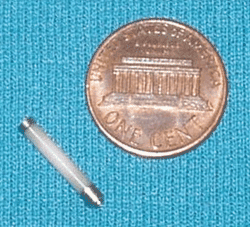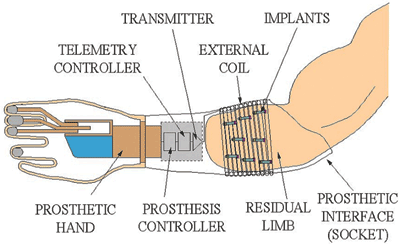Advancing prosthetic limb technology with robotics
The key is taking into account how and where to place the sensors
BY THERESE PHILIPPI, Program Manager
Alion Science and Technology
www.alionscience.com
and
DR. PHILIP TROYK, President
Sigenics
www.sigenics.com
Advanced electronic sensors and circuitry combined with computer modeling and simulation are two of the leading technologies driving developments in robotic control technology for bringing specialized enhancements to prosthetic limbs. Currently, Alion Science and Technology and Sigenics engineers are concentrating on limb replacement for the upper extremities, but that work is applicable to all limb prostheses.
The team is enhancing technology for Implantable MyoElectric Sensors (IMES), as well as using modeling and simulation, to improve the affordability and functionality of robotically controlled prosthetic limbs. IMES, placed within the amputee’s residual limb, senses small muscle movements to control the prosthetic limb.
The implantable electric sensor wirelessly sends out muscle control signals used to operate the prosthetic limb. The implantable devices contain electronics within a 1-cm-long ceramic capsule and can be non-surgically placed within the residual limb via a hypodermic needle.

IMES implant: The electrodes are at each end. Inter-electrode spacing is appropriate for whole muscle activity recordings.
Since every amputee and amputation is different, each prosthetic limb must be customized. One step in making robotically controlled limbs more cost effective is the development and application of virtual prototyping simulation models. This work entails the development of a protocol and modeling tool for use of the sensors with robotic upper-limb prosthetics, toward the goals of affordability and higher power-efficiency.
Virtual prototyping
Virtual 3D prototype models of human limbs, based on low-cost ultrasound technology, will provide an enhanced view of the limb structure and evaluate the possibilities for prosthesis control. Depending on which of the normal 18 muscles in the forearm of an amputee can be sensed, this 3D prototyping tool will encompass imaging, modeling, and virtual simulation to strategically place the sensors; if fewer sensors can be used, costs will be lower.
Implanting where most effective

Use Implantable Myoelectric Sensors (IMES) to Create Additional Myoelectric Control Sites: Sense myoelectric signal at its source, so it acts as an amplifier of the neural command. Use inductive coupling to pass power into devices and signal out of device without breaking the skin.
Following injury and surgery, only a fraction of an amputee’s intact nerves and muscles are typically present, so the ability to precisely determine where to place the sensors will allow adaptation of the control technology to meet each amputee’s needs. Through modeling, an IMES device can be implanted where it is most effective, providing user-specific placement and customized functionality.
Virtual computer optimization not only increases the likelihood of a more useful prosthesis, but it also decreases the tendency to over-prescribe, resulting in overall cost reduction. The prototyping program is designed to augment and accelerate the development and affordability of these electronic sensors; the development and application of virtual prototyping simulation models that will ultimately help the amputee to learn more effective control of his or her prosthesis.
The virtual model that is being developed will be used to design a simplified system that is optimal to the patient, allowing the most effective user control. Advanced robotics are crucial to program success and are the gateway for human-controlled robotics. This program is expected to result in a protocol and model for developing an optimal robotic prosthetic device for a specific amputee, lower cost sensors for embedding within a limb and an advanced integrated control system that allows for lighter, more comfortable and more cost-effective prostheses. ■ ■
A minimalist approach
While current research efforts seek to develop a universal, “one-size fits all” robotically controlled prosthetic limb device, modeling and simulation will be integral to investigate a minimalist approach where each device is unique to a specific amputee. This approach offers the potential to reduce major cost drivers including the number of implantable sensors required, the amount of time and surgical labor required to “fit” an amputee, as well as the weight and power requirements of a robotically controlled prosthetic. ■
Advertisement
Learn more about Alion Science and Technology





